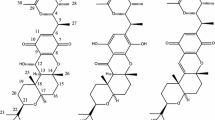Abstract
A total of 81 Thai medicinal plant species collected from forests in four geographical regions of Thailand were examined for the presence of endophytic fungi with biological activity. Of 582 pure isolates obtained, 360 morphologically distinct fungi were selected for cultivation on malt Czapek broth and yeast extract sucrose broth, from which extracts were tested for biological activity. Extracts of 92 isolates could inhibit Mycobacterium tuberculosis (MIC 0.0625–200 μg ml−1) when tested by the microplate Alamar blue assay, while extracts of six inhibited Plasmodium falciparum (IC50 of 1.2–9.1 μg ml−1) as determined by the [3H]hypoxanthine incorporation method. Strong anti-viral activity against Herpes simplex virus type 1 was observed in 40 isolates (IC50 of 0.28–50 μg ml−1). The sulphorhodamine B assay for activity against cancer cell lines revealed that 60 were active against human oral epidermoid carcinoma cells (EC50 0.42–20 μg ml−1) and 48 against breast cancer cells (EC50 0.18–20 μg ml−1). Bioactivity profile was affected by the type of culture medium. Given the high incidence of bioactive extracts and the fact that most of the isolated fungi could not be identified due to lack of spore formation, the results suggested that Thai medicinal plants can provide a wide variety of endophytes that might be a potential source of novel bioactive compounds.
Similar content being viewed by others
References
Bremer, K., Chase, M.W., Stevens, P.F., et al. 1998 An ordinal classification for the families of flowering plants. Annals of the Missouri Botanical Garden 85, 531–553.
Carr, G.D. 2002 Flowering Vascular Plant Families [online]. University of Hawaii, Botany Department. Available from http://www.botany.hawaii.edu/faculty/carr/phylo_fpfamilies.htm [updated 10 August 2002; cited 12 October 2002].
Collins, L.A. & Franzblau, S.G. 1997 Microplate Alamar blue assay versus BACTEC 460 system for high throughput screening of compounds against Mycobacterium tuberculosis and Mycobacterium avium. Antimicrobial Agents and Chemotherapy 41, 1004–1009.
Cowman, A.F. & Duraisingh, M.T. 2001 An old enemy, a new battle plan: perspectives on combating drug-resistance malaria. EMBO Reports 2, 77–79.
Desjardins, R.E., Canfield, C.J., Haynes, J.D. & Chulay, J.D. 1979 Quantitative assessment of antimalarial activityin vitro by a semiautomated microdilution technique. Antimicrobial Agents and Chemotherapy 16, 710–718.
Espinel, M.A., Laszlo, A., Simonsen, L., Boulahbal, F., Kim, S.J., Reniero, A., Hoffner, S., Rieder, H.L., Binkin, N., Dye, C., Williams, R. & Raviglione, M.C. 2001 Global trends in resistance to antituberculosis drugs. The New England Journal of Medicine 344, 1294–1303.
Hawariah, A. & Stanslas, J. 1998 In vitro response of human breast cancer cell lines to the growth-inhibitory effects of styrylpyrone derivative (SPD) and assessment of its antiestrogenicity. Anticancer Research 18, 4383–4386.
Inderlied, C.B. & Salfinger, M. 1999 Antimycobacterial agents and susceptibility tests. In Manual of Clinical Microbiology, 7th edn, eds. Murray, P.R., Baron, E.J., Pfaller, M.A., Tenover, F.C. & Yolken, R.H. pp. 1601–1623. Washington, DC: ASM Press. ISBN 1-55581-126-4.
Ito, C., Katsuno, S., Itogawa, M., Ruangrungsi, N., Mukainaka, T., Okuda, M., Kitakawa, Y., Tokuda, H., Nishino, H. & Furukawa, H. 2000 New carbazole alkaloids from Clausena anisata with antitumor promoting activity. Journal of Natural Products 63, 125–128.
Likhitwitayawuid, K., Chanmahasathien, W., Ruangrungsi, N. & Krungkrai, J. 1998 Xanthones with antimalarial activity from Garcinia dulcis. Planta Medica 64, 281–282.
Makler, M.T. & Hinrichs, D.J. 1993 Measurement of the lactate dehydrogenase activity of Plasmodium falciparum as an assessment of parasitemia. The American Journal of Tropical Medicine and Hygiene 48, 205–210.
Panthong, A., Kanjanapothi, D. & Taylor, W.C. 1986 Ethnobotanical review of medicinal plants from Thai traditional books, Part I: Plants with anti-inflammatory, anti-asthmatic and antihypertensive properties. Journal of Ethnopharmacology 18, 213–228.
Panthong, A., Kanjanapothi, D., Taesotikul, T. & Taylor, W.C. 1991 Ethnobotanical review of medicinal plants from Thai traditional books, Part II: Plants with antidiarrheal, laxative and carminative properties. Journal of Ethnopharmacology 31, 121–156.
Paterson, R.R.M. & Bridge, P.D. 1994 Biochemical Techniques for Filamentous Fungi. pp. 5–7. Oxon: CAB International. ISBN 0-85198-899-7.
Petrini, O. 1991 Fungal endophytes of tree leaves. In Microbial Ecology of Leaves, eds. Andrews, J.H. & Hirano, S.S. pp. 179–197. New York: Springer-Verlag. ISBN 0-38797-5799.
Phrutivorapongkul, A., Lipipun, V., Ruangrungsi, N., Watanabe, T. & Ishikawa, T. 2002 Studies on the constituents of seeds of Pachyrrhizus erosus and their anti-herpes simplex virus (HSV) activities. Chemical and Pharmaceutical Bulletin 50, 534–537.
Pillay, D. & Zambon, M. 1998 Antiviral drug resistance. British Medical Journal 317, 660–662.
Pisani, P., Parkin, D.M., Bray, F. & Ferlay, J. 1999 Estimates of the worldwide mortality from 25 cancers in 1990 International Journal of Cancer 83, 870–873.
Saikkonen, K., Faeth, S.H., Helander, M. & Sullivan, T.J. 1998 Fungal endophytes: a continuum of interactions with host plants. Annual Review of Ecological System 29, 319–343.
Skehan, P., Storeng, R., Scudiero, D., Monks, A., McMahan, J., Vistica, D., Warren, J.T., Bokesch, H., Kenney, S. & Boyd, M.R. 1990 New colorimetric cytotoxicity assay for anticancer-drug screening. Journal of the National Cancer Institute 82, 1107–1112.
Stierle, A., Strobel, G., Stierle, D., Grothaus, P. & Bignami, G. 1995 The search for a taxol-producing microorganism among the endophytic fungi of the pacific yew, Taxus brevifolia. Journal of Natural Products 58, 1315–1324.
Swierkosz, E.M. & Hodinka, R.L. 1999 Antiviral agents and susceptibility tests. In Manual of Clinical Microbiology, 7th edn, eds. Murray, P.R., Baron, E.J., Pfaller, M.A., Tenover, F.C. & Yolken, R.H. pp. 1624–1639. Washington, DC: ASM Press. ISBN 1-55581-126-4.
Tan, R.X. & Zou, W.X. 2001 Endophytes: a rich source of functional metabolites. Natural Product Reports 18, 448–459.
Trager, W. & Jensen, J.B. 1976 Human malaria parasites in continuous culture. Science 193, 673–675
Author information
Authors and Affiliations
Corresponding author
Rights and permissions
About this article
Cite this article
Wiyakrutta, S., Sriubolmas, N., Panphut, W. et al. Endophytic fungi with anti-microbial, anti-cancer and anti-malarial activities isolated from Thai medicinal plants. World Journal of Microbiology and Biotechnology 20, 265–272 (2004). https://doi.org/10.1023/B:WIBI.0000023832.27679.a8
Issue Date:
DOI: https://doi.org/10.1023/B:WIBI.0000023832.27679.a8



